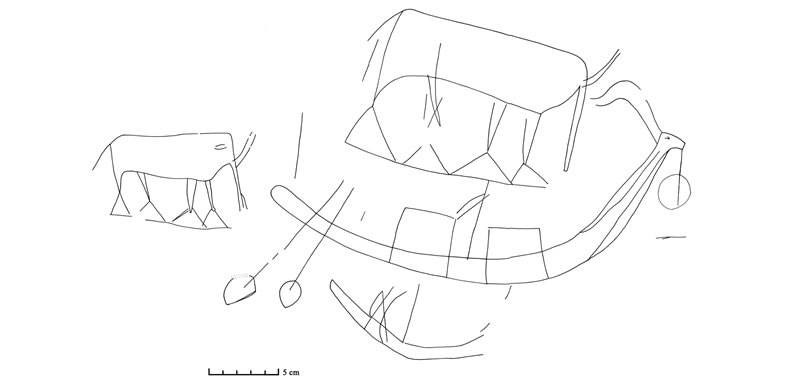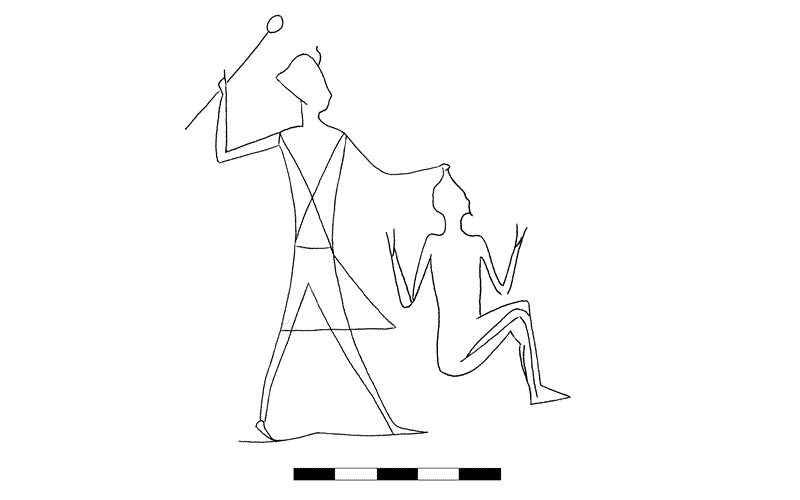The Rock Inscriptions of the Wadi Magar
The principal elements of these inscriptions are two late Predynastic tableaux, and a series of small images of the god Seth in association with a “miniature” scene of a pharaoh smiting an enemy. The main concentration of inscriptions in the Wadi Magar consists primarily pf Predynastic images, including a large tableau in which images of impaled crocodiles — perhaps crocodile topped standards — figure prominently.
A single vignette of Elephant-on-the-Mountain occupies a position near the main site. Deeper in the wadi is a site containing both Predynastic and New Kingdom inscriptions, with some of the rare depictions of the god Seth from the Theban Western Desert. Nearby are a few additional depictions.
The Vignette of Elephant-on-the-Gebel
This vignette, occupying an east facing area of smooth stone beneath a small limestone pinnacle opposite the main site, bears a reference to Late Predynastic royalty. The dominating element of the scene is an animal-headed boat, facing right, with twin cabins and large, round-bladed steering oars.1 Emerging from the deck of the vessel, between the two cabins, is a pole — twin streamers hanging down and to the left from the upper portion thereof — surmounted by standard in the form of a large elephant atop a four-peaked mountain.2 Below the vessel is a smaller, high-prowed boat, behind which appears a smaller image of the elephant upon the four-peaked mountain. The smaller vessel is apparently an escort boat, of a sort present in later, Old-Kingdom images of royal vessels,3 perhaps corresponding to the towboats of later riverine processions. As in other Predynastic and Protodynastic images, the group of large ceremonial or ritual vessel and smaller tender boat appear to represent a vignette from the greater Jubilee cycle.4

The closest parallels for the nautical elephant standard in the Wadi Magar are the elephant standard on a painted Marl A1 vessel in the Ashmoleon Museum,5 and the elephant-on-mountain standards atop vessels on the Metropolitan Knife Handle.6 Appearing on the Coptos colossus in the Cairo Museum, at Gebel Tjauti, and in tomb Uj at Abydos, the early composite sign of the elephant on the mountain may represent the name of a Predynastic Upper Egyptian ruler.7 With Hierakonpolis, Naqada is a center of Predynastic depictions of elephants. Lacking the rounded ears of Naqada I elephants, and giving no evidence of the butterfly ears or jutting jaw of early Naqada II elephants, the elephants in the Wadi Magar vignette, with ears large and lines within the bodies, and large and prominent tusks, are iconographically parallel to the pachyderm representations that resume in a royal context during the Naqada IID Period.8
The Seth Site, Lower Images: Smiting Scene
Smiting scenes appear in rock art already during the late Predynastic Period,9 with notable tableaux dating to the Old Kingdom,10 at least one small and rough New Kingdom version in the Theban rock inscriptions,11 and a late echo thereof in the south in the form of the rock stela of Sherikarer.12 A painted smiting pharaoh from the Western Desert, at Abu Ballas southwest of Dakhla Oasis, wears a white crown with horizontal ram horns and probably dates to the early Fourth Dynasty.13 The image also appears in Nubian rock art.14

The smiting king in the present tableau wears a blue crown and pointed kilt; a broad-collar and crossed bands complete the pharaoh’s costume. The crossed bands may be an abbreviated depiction of the winged cuirass that the king often wears into battle. The mace in the king’s raised left hand does not have a bladed additional and a rather miniscule head. The naked enemy appears in a squatting position, his elbows bent and hands raised to either side of his shoulders; he faces to the right away from the smiting king. His only attribute is a small pointed beard, which is not inappropriate to a location west of Naqada if he is meant to represent one of the Libyan bandits whom the local patrol might have encountered periodically. The squatting position of the enemy may result from an incomplete representation — or perhaps misunderstanding — of the usual Knielauf pose of those whom the pharaoh smites.15
Notes
- 1. Compare Červicek, Nord-Etbai, fig. 474.
- 2. For the outsized standard, compare Weigall, ASAE 8 (1907): 49-50.
- 3. Compare el Awady, CASAE 37/1 (2008): 182-183 (ref. courtesy D. Klotz).
- 4. Darnell, Archéo-Nil 19 (2009): 94-97.
- 5. Payne, Catalog of the Predynastic Egyptian Collection, pp. 107-108 (no. 865, dated Naqada IId1); Asselberghs, Chaos en Beheersing, pls. 10-11.
- 6. See the facsimile copy by U. Effland, displayed with the original in the Metropolitan Museum of Art.
- 7. Amongst the many comments see Darnell, et al., Theban Desert Road Survey 1, pp. 17-18 and 20-24; Dreyer, Umm El-Qaab I, pp. 175-180.
- 8. Friedman, in Hendrickx, Friedman, Ciałowicz, and Chłodnicki, eds., Egypt at its Origins, p. 161.
- 9. Cf. the “Scorpion Tableau” at nearby Gebel Tjauti—Darnell, et al., Theban Desert Road Survey 1, pp. 10-19. Morrow and Morrow, Desert RATS, p. 226, fig. 17, may be of a slightly later, Protodynastic or Early Dynastic date.
- 10. Cf. Ibrahim and Tallet, RdE 59 (2008): 155-180; idem, Archéo-Nil 19 (2009): 179-184; Valbelle, in Valbelle and Bonnet, eds. Le Sinaï, pp. 50-51.
- 11. Spiegelberg, Graffiti, pl. 58 (no. 494; tthe pharaoh there is running the enemy through with a spear, no longer visible — compare De Morgan, et al., Frontière de Nubie, p. 20, no. 123).
- 12. Hintze, Kush 7 (1959): plate facing p. 190.
- 13. Kuhlmann, MDAIK 61 (2005): 285-286; Berger, in Archaeology of Early Northeastern Africa, pp. 203 and 205.
- 14. Basch and Gorbea, Estudios de arte rupestre Nubio 1, pp. 166-170, figs. 159, 160, and pl. 22.
- 15. Compare the images collected in Hall, Pharaoh Smites his Enemies.
